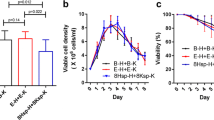Abstract
Toll-like receptors (TLRs) mediate immune responses upon recognition of a variety of ligands. To further elucidate the function of TLRs, it is important to identify novel ligands and their action mechanisms including polymer assembly. In this study, we propose an efficient method for preparation of the extracellular domain of human Toll-like receptor 6 (TLR6ED) in Escherichia coli using the bubbling cultivation method. Our preparation method improved the level of expression of TLR6ED into a soluble fraction as compared with typical cultivation using a rotary shaker. Circular dichroism (CD) experiments confirmed the structural formation of TLR6ED with secondary structure contents similar to leucine-rich repeat (LRR) modules. In addition, we also provided a procedure for preparing this recombinant protein using Sf9 insect cells, which ensures preservation of some key posttranslational modifications often lacking in bacteria-expressed proteins. These materials would be useful for analyzing novel molecules that bind directly to TLR6, complex formations with other regulators including TLR2 and TLR4, and the functional effects of N-linked glycosylation.





Similar content being viewed by others
Abbreviations
- TLR:
-
Toll-like receptor
- LRR:
-
Leucine-rich repeat
- PAMP:
-
Pathogen-associated molecular pattern
- TLR6ED :
-
Extracellular domain of human TLR6
- Sf9:
-
Spodoptera frugiperda 9
- PCR:
-
Polymerase chain reaction
- GST:
-
Glutathione S-transferase
- LB:
-
Lysogeny-Broth
- OD600 :
-
Optical density at 600 nm
- IPTG:
-
Isopropyl β-d-1-thiogalactopyranoside
- SDS-PAGE:
-
Sodium dodecyl sulphate-polyacrylamide gel electrophoresis
- CBB:
-
Coomassie Brilliant Blue
- MOI:
-
Multiplicity of infection
- PBS:
-
Phosphate buffered saline
- CD:
-
Circular dichroism
- DLS:
-
Dynamic light scattering
- VLRB:
-
Variable lymphocyte receptor B
References
Janeway CAJ, Medzhitov R (2002) Innate immune recognition. Annu Rev Immunol 20:197–216
Bell JK, Mullen GE, Leifer CA, Mazzoni A, Davies DR, Segal DM (2003) Leucine-rich repeats and pathogen recognition in Toll-like receptors. Trends Immunol 24(10):528–533
Slack JL, Schooley K, Bonnert TP, Mitcham JL, Qwarnstrom EE, Sims JE, Dower SK (2000) Identification of two major sites in the type I interleukin-1 receptor cytoplasmic region responsible for coupling to pro-inflammatory signaling pathways. J Biol Chem 275(7):4670–4678
Kulkarni R, Behboudi S, Sharif S (2011) Insights into the role of Toll-like receptors in modulation of T cell responses. Cell Tissue Res 343(1):141–152
Akira S, Takeda K (2004) Toll-like receptor signaling. Nat Rev Immunol 4(7):499–511
Oliveira-Nascimento L, Massari P, Wetzler LM (2012) The role of TLR2 in infection and immunity. Front Immunol 3:79
Shimizu T, Kida Y, Kuwano K (2008) Ureaplasma parvum lipoproteins, including MB antigen, activate NF-κB through TLR1, TLR2 and TLR6. Microbiology 154(Pt 5):1318–1325
Stewart CR, Stuart LM, Wilkinson K, van Gils JM, Deng J, Halle A, Rayner KJ, Boyer L, Zhong R, Frazier WA, Lacy-Hulbert A, El Khoury J, Golenbock DT, Moore KJ (2010) CD36 ligands promote sterile inflammation through assembly of a Toll-like receptor 4 and 6 heterodimer. Nat Immunol 11(2):155–161
Kato Y, Sawano Y, Tanokura M (2006) Expression and purification of active WW domains of FBP11/HYPA and FBP28/CA150. Protein Pept Lett 13(2):197–201
Scholtz JM, Qian H, York EJ, Stewart JM, Baldwin RL (1991) Parameters of helix-coil transition theory for alanine-based peptides of varying chain lengths in water. Biopolymers 31(13):1463–1470
Provencher SW, Glöckner J (1981) Estimation of globular protein secondary structure from circular dichroism. Biochemistry 20(1):33–37
Käll L, Krogh A, Sonnhammer EL (2007) Advantages of combined transmembrane topology and signal peptide prediction—the Phobius web server. Nucleic Acids Res 35(2):W429–W432
Takeuchi O, Kawai T, Sanjo H, Copeland NG, Gilbert DJ, Jenkins NA, Takeda K, Akira S (1999) TLR6: a novel member of an expanding Toll-like receptor family. Gene 231(1–2):59–65
Kang JY, Nan X, Jin MS, Youn SJ, Ryu YH, Mah S, Han SH, Lee H, Paik SG, Lee JO (2009) Recognition of lipopeptide patterns by Toll-like receptor 2-Toll-like receptor 6 heterodimer. Immunity 31(6):873–884
Enkhbayar P, Kamiya M, Osaki M, Matsumoto T, Matsushima N (2004) Structural principles of leucine-rich repeat (LRR) proteins. Proteins 54(3):394–403
Ozinsky A, Underhill DM, Fontenot JD, Hajjar AM, Smith KD, Wilson CB, Schroeder L, Aderem A (2000) The repertoire for pattern recognition of pathogens by the innate immune system is defined by cooperation between toll-like receptors. Proc Natl Acad Sci USA 97(25):13766–13771
Jin MS, Kim SE, Heo JY, Lee ME, Kim HM, Paik SG, Lee H, Lee JO (2007) Crystal structure of the TLR1-TLR2 heterodimer induced by binding of a tri-acylated lipopeptide. Cell 130(6):1071–1082
Liu L, Botos I, Wang Y, Leonard JN, Shiloach J, Segal DM, Davies DR (2008) Structural basis of toll-like receptor 3 signaling with double-stranded RNA. Science 320(5874):379–381
Park BS, Song DH, Kim HM, Choi BS, Lee H, Lee JO (2009) The structural basis of lipopolysaccharide recognition by the TLR4-MD-2 complex. Nature 458(7242):1191–1195
Hyakushima N, Mitsuzawa H, Nishitani C, Sano H, Kuronuma K, Konishi M, Himi T, Miyake K, Kuroki Y (2004) Interaction of soluble form of recombinant extracellular TLR4 domain with MD-2 enables lipopolysaccharide binding and attenuates TLR4-mediated signaling. J Immunol 173(11):6949–6954
da Silva Correia J, Ulevitch RJ (2002) MD-2 and TLR4 N-linked glycosylations are important for a functional lipopolysaccharide receptor. J Biol Chem 277(3):1845–1854
Acknowledgements
This work was supported by a Grant-in-Aid for Scientific Research (S) (Grant Number 23228003) from the Japan Society for the Promotion of Science (JSPS) and the Platform for Drug Discovery, Informatics, and Structural Life Science of the Ministry of Education, Culture, Sports, Science and Technology (MEXT), Japan.
Author information
Authors and Affiliations
Corresponding author
Ethics declarations
Conflict of interest
The authors declare no conflict of interests.
Ethical Approval
This article does not contain any studies with human participants or animals performed by any of the authors.
Rights and permissions
About this article
Cite this article
Miyakawa, T., Kumazawa, A., Fuke, Y. et al. Preparation of the Extracellular Domain of Recombinant Human Toll-like Receptor 6. Protein J 36, 28–35 (2017). https://doi.org/10.1007/s10930-016-9692-8
Published:
Issue Date:
DOI: https://doi.org/10.1007/s10930-016-9692-8




